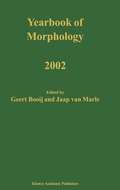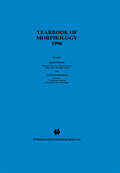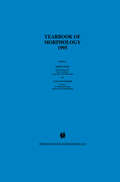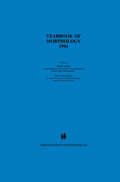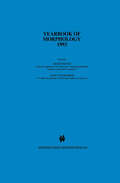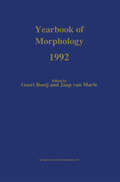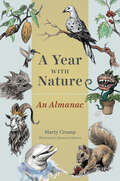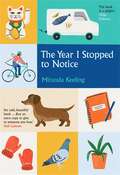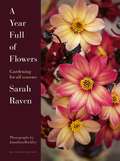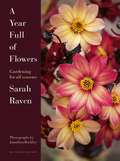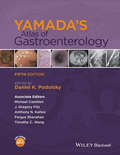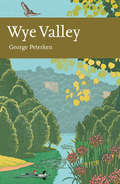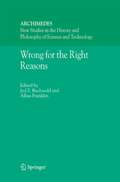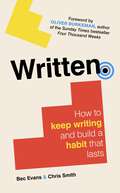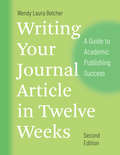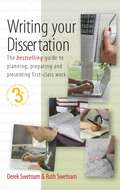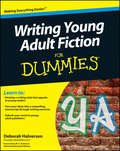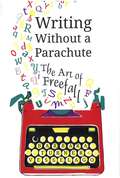- Table View
- List View
Yearbook of Morphology 2002 (Yearbook of Morphology)
by G. E. Booij Jaap Van MarleThe Yearbook of Morphology 2002 discusses the morphology of a variety of pidgin and Creole languages which appear to have much more morphology than traditionally assumed. Other topics include the morphological use of truncation for the coinage of proper names in Germanic and Romance languages, the way affixes are combined and ordered in complex words, and the complex linguistic principles behind these orderings.
Yearbook of Morphology 1996 (Yearbook of Morphology)
by JaapMarle GeertBooijA revival of interest in morphology has occurred during recent years. Since 1988, the Yearbook of Morphology book series has proven to be an eminent platform for the growth of morphological research, containing articles on topics that are central in the current theoretical debates. The Yearbook of Morphology 1996 focuses on the relationship between morphology and psycholinguistics. Basic questions such as the following are discussed. To what extent does the morphological structure of a word play a role in its perception and production? Are regular complex words created anew each time they are used, or are they stored in the lexicon? The relevant evidence comes from a variety of European languages. Another important theme in this yearbook is the degree of autonomy of morphology: in which respect does it differ from other modules of the grammar? The present yearbook also contains articles on periphrasis, the nature of inflectional morphology and syncretism in derivational morphology. Audience: Theoretical and historical linguists, morphologists, phonologists and psycholinguists will find this book of interest.
Yearbook of Morphology 1995 (Yearbook of Morphology)
by JaapMarle GeertBooijA revival of interest in morphology has occurred during recent years. The aim of the Yearbook of Morphology series is to support and enforce this upswing of morphological research and to give an overview of the current issues and debates at the heart of this revival. The Yearbook of Morphology 1995 focuses on an important issue in the current morphological debate: the relation between inflection and word formation. What are the criteria for their demarcation, in which ways do they interact and how is this distinction acquired by children? The papers presented here concur in rejecting the `split morphology hypothesis' that claims that inflection and word formation belong to different components of the grammar. This volume also deals with the marked phenomenon of subtractive morphology and its theoretical implications. Theoretical and historical linguists, morphologists, phonologists and psycholinguists interested in linguistic issues will find this book of interest.
Yearbook of Morphology 1994 (Yearbook of Morphology)
by Geert Booij Jaap Van MarleRecent years have seen a revival of interest in morphology. The Yearbook of Morphology series supports and enforces this upswing of morphological research and gives an overview of the current issues and debates at the heart of this revival. The Yearbook of Morphology 1994 focuses on prosodic morphology, i.e. the interaction between morphological and prosodic structure, on the semantics of word formation, and on a number of related issues in the realm of inflection: the structure of paradigms, the relation between inflection and word formation, and patterns of language change with respect to inflection. There is also discussion of the relevance of the notion `level ordering' for morphological generalizations. All theoretical and historical linguists, morphologists, and phonologists will want to read this book.
Yearbook of Morphology 1993 (Yearbook of Morphology)
by Geert Booij Jaap Van MarleRecent years have seen a revival of interest in morphology. The Yearbook of Morphology series supports and enforces this upswing of morphological research and gives an overview of the current issues and debates at the heart of this revival. The Yearbook of Morphology 1993 focuses on prosodic morphology, i.e. the interaction between morphological and prosodic structure, on the semantics of word formation, and on a number of related issues in the realm of inflection: the structure of paradigms, the relation between inflection and word formation, and patterns of language change with respect to inflection. There is also discussion of the relevance of the notion `level ordering' for morphological generalizations. All theoretical and historical linguists, morphologists, and phonologists will want to read this volume.
Yearbook of Morphology 1992 (Yearbook of Morphology)
by Geert Booij Jaap Van MarleA revival of interest in morphology has taken place during recent years and the subject is seen now as a relatively autonomous subdiscipline of linguistics. As one of the important areas of theoretical research in formal linguistics, morphology has attracted linguists to investigate its relations to syntax, semantics, phonology, psycholinguistics and language change. The aim of the Yearbook of Morphology, therefore, is to support and enforce the upswing of morphological research and to give an overview of the current issues and debates at the heart of this revival.
A Year with Nature: An Almanac
by Marty CrumpA Year with Nature is an almanac like none you’ve ever seen: combining science and aesthetics, it is a daily affirmation of the extraordinary richness of biodiversity and our enduring beguilement by its beauty. With a text by herpetologist and natural history writer Marty Crump and a cornucopia of original illustrations by Bronwyn McIvor, this quirky quotidian reverie gazes across the globe, media, and time as it celebrates date-appropriate natural topics ranging from the founding of the National Park Service to annual strawberry, garlic, shrimp, hummingbird, and black bear festivals. With Crump, we mark the publication of classics like Carson’s Silent Spring and White’s Charlotte’s Web, and even the musical premiere of Tchaikovsky’s Swan Lake. We note the discovery of the structure of DNA and the mountain gorilla, the rise of citizen science projects, and the work of people who’ve shaped how we view and protect nature—from Aristotle to E. O. Wilson. Some days feature US celebrations, like National Poinsettia Day and National Cat Day; others highlight country-specific celebrations, like Australia’s Wombat Day and Thailand’s Monkey Buffet Festival, during which thousands of macaques feast on an ornately arranged spread of fruits and vegetables. Crump also highlights celebrations that span borders, from World Wildlife Conservation Day to International Mountain Day and global festivities for snakes, sea turtles, and chocolate. Interweaving fascinating facts on everything from jellyfish bodies to monthly birth flowers with folkloric entries featuring the Loch Ness Monster, unicorns, and ancient Greek, Roman, and Egyptian mythology, the almanac is as exhaustive as it is enchanting. A Year with Nature celebrates the wonder and beauty of our natural world as we have expressed it in visual arts, music, literature, science, natural history, and everyday experience. But more than this, the almanac’s vignettes encourage us to contemplate how we can help ensure that future generations will be able to enjoy the landscapes and rich biodiversity we so deeply cherish.
A Year with Nature: An Almanac
by Marty CrumpA Year with Nature is an almanac like none you’ve ever seen: combining science and aesthetics, it is a daily affirmation of the extraordinary richness of biodiversity and our enduring beguilement by its beauty. With a text by herpetologist and natural history writer Marty Crump and a cornucopia of original illustrations by Bronwyn McIvor, this quirky quotidian reverie gazes across the globe, media, and time as it celebrates date-appropriate natural topics ranging from the founding of the National Park Service to annual strawberry, garlic, shrimp, hummingbird, and black bear festivals. With Crump, we mark the publication of classics like Carson’s Silent Spring and White’s Charlotte’s Web, and even the musical premiere of Tchaikovsky’s Swan Lake. We note the discovery of the structure of DNA and the mountain gorilla, the rise of citizen science projects, and the work of people who’ve shaped how we view and protect nature—from Aristotle to E. O. Wilson. Some days feature US celebrations, like National Poinsettia Day and National Cat Day; others highlight country-specific celebrations, like Australia’s Wombat Day and Thailand’s Monkey Buffet Festival, during which thousands of macaques feast on an ornately arranged spread of fruits and vegetables. Crump also highlights celebrations that span borders, from World Wildlife Conservation Day to International Mountain Day and global festivities for snakes, sea turtles, and chocolate. Interweaving fascinating facts on everything from jellyfish bodies to monthly birth flowers with folkloric entries featuring the Loch Ness Monster, unicorns, and ancient Greek, Roman, and Egyptian mythology, the almanac is as exhaustive as it is enchanting. A Year with Nature celebrates the wonder and beauty of our natural world as we have expressed it in visual arts, music, literature, science, natural history, and everyday experience. But more than this, the almanac’s vignettes encourage us to contemplate how we can help ensure that future generations will be able to enjoy the landscapes and rich biodiversity we so deeply cherish.
A Year with Nature: An Almanac
by Marty CrumpA Year with Nature is an almanac like none you’ve ever seen: combining science and aesthetics, it is a daily affirmation of the extraordinary richness of biodiversity and our enduring beguilement by its beauty. With a text by herpetologist and natural history writer Marty Crump and a cornucopia of original illustrations by Bronwyn McIvor, this quirky quotidian reverie gazes across the globe, media, and time as it celebrates date-appropriate natural topics ranging from the founding of the National Park Service to annual strawberry, garlic, shrimp, hummingbird, and black bear festivals. With Crump, we mark the publication of classics like Carson’s Silent Spring and White’s Charlotte’s Web, and even the musical premiere of Tchaikovsky’s Swan Lake. We note the discovery of the structure of DNA and the mountain gorilla, the rise of citizen science projects, and the work of people who’ve shaped how we view and protect nature—from Aristotle to E. O. Wilson. Some days feature US celebrations, like National Poinsettia Day and National Cat Day; others highlight country-specific celebrations, like Australia’s Wombat Day and Thailand’s Monkey Buffet Festival, during which thousands of macaques feast on an ornately arranged spread of fruits and vegetables. Crump also highlights celebrations that span borders, from World Wildlife Conservation Day to International Mountain Day and global festivities for snakes, sea turtles, and chocolate. Interweaving fascinating facts on everything from jellyfish bodies to monthly birth flowers with folkloric entries featuring the Loch Ness Monster, unicorns, and ancient Greek, Roman, and Egyptian mythology, the almanac is as exhaustive as it is enchanting. A Year with Nature celebrates the wonder and beauty of our natural world as we have expressed it in visual arts, music, literature, science, natural history, and everyday experience. But more than this, the almanac’s vignettes encourage us to contemplate how we can help ensure that future generations will be able to enjoy the landscapes and rich biodiversity we so deeply cherish.
A Year with Nature: An Almanac
by Marty CrumpA Year with Nature is an almanac like none you’ve ever seen: combining science and aesthetics, it is a daily affirmation of the extraordinary richness of biodiversity and our enduring beguilement by its beauty. With a text by herpetologist and natural history writer Marty Crump and a cornucopia of original illustrations by Bronwyn McIvor, this quirky quotidian reverie gazes across the globe, media, and time as it celebrates date-appropriate natural topics ranging from the founding of the National Park Service to annual strawberry, garlic, shrimp, hummingbird, and black bear festivals. With Crump, we mark the publication of classics like Carson’s Silent Spring and White’s Charlotte’s Web, and even the musical premiere of Tchaikovsky’s Swan Lake. We note the discovery of the structure of DNA and the mountain gorilla, the rise of citizen science projects, and the work of people who’ve shaped how we view and protect nature—from Aristotle to E. O. Wilson. Some days feature US celebrations, like National Poinsettia Day and National Cat Day; others highlight country-specific celebrations, like Australia’s Wombat Day and Thailand’s Monkey Buffet Festival, during which thousands of macaques feast on an ornately arranged spread of fruits and vegetables. Crump also highlights celebrations that span borders, from World Wildlife Conservation Day to International Mountain Day and global festivities for snakes, sea turtles, and chocolate. Interweaving fascinating facts on everything from jellyfish bodies to monthly birth flowers with folkloric entries featuring the Loch Ness Monster, unicorns, and ancient Greek, Roman, and Egyptian mythology, the almanac is as exhaustive as it is enchanting. A Year with Nature celebrates the wonder and beauty of our natural world as we have expressed it in visual arts, music, literature, science, natural history, and everyday experience. But more than this, the almanac’s vignettes encourage us to contemplate how we can help ensure that future generations will be able to enjoy the landscapes and rich biodiversity we so deeply cherish.
The Year I Stopped to Notice
by Miranda Keeling'This book is a delight ... the world is full of little surprises, momentary little fountains of pleasure and beauty, that could be visible to all of us if we learned to stop and notice as Miranda Keeling does.' Philip Pullman'An odd, beautiful book ... Buy an extra copy to give to someone you love.' Neil GaimanJanuary: A man walking along Caledonian Road falls over onto the huge roll of bubble wrap he is hugging, perhaps for just this sort of situation. Inspired by her popular Twitter account, The Year I Stopped to Notice brings together Miranda Keeling's observations of the magic, humour, strangeness and beauty in ordinary life. Through the changing seasons, on city streets and on buses, in parks and cafes, Miranda notices things: moments between friends, the interactions of strangers, children delighting in the world around them, the quiet melancholy of lost items on the pavement.Accompanied by stunning watercolour illustrations from Luci Power, Miranda's poetic vignettes take us on journeys of discovery and share with us the joy of stopping to notice. September: On a sweltering, packed rush-hour train, my arm suddenly feels lovely and cool, and I look down to see a shopping bag held by the woman beside me - full of just-bought cartons of milk.
A Year Full of Flowers: Gardening for all seasons
by Sarah RavenInspiration, planting ideas and expert advice for a beautiful garden all-year roundColour and scent are the hallmarks of Sarah Raven's style – and they are simple luxuries that everyone can bring into their garden.A Year Full of Flowers reveals the hundreds of hardworking varieties that make the garden sing each month, together with the practical tasks that ensure everything is planted, staked and pruned at just the right time.Tracing the year from January to December at her home, Perch Hill, Sarah offers a complete and transporting account of a garden crafted over decades. Sharing the lessons learned from years of plant trials, she explains the methods that have worked for her, and shows you how to achieve a space that's full of life and colour.Discover long-lasting, divinely scented tulips, roses that keep flowering through winter, the most magnificent dahlias and show-stopping alliums, as well as how to grow sweet peas up a teepee, take cuttings from chrysanthemums and stop mildew in its tracks.This is passionate, life-enriching gardening; it's also simple, adaptable and can work for you. Sarah has made the garden central to her life – this book shows you how you can too.
A Year Full of Flowers: Gardening for all seasons
by Sarah RavenInspiration, planting ideas and expert advice for a beautiful garden all-year roundColour and scent are the hallmarks of Sarah Raven's style – and they are simple luxuries that everyone can bring into their garden.A Year Full of Flowers reveals the hundreds of hardworking varieties that make the garden sing each month, together with the practical tasks that ensure everything is planted, staked and pruned at just the right time.Tracing the year from January to December at her home, Perch Hill, Sarah offers a complete and transporting account of a garden crafted over decades. Sharing the lessons learned from years of plant trials, she explains the methods that have worked for her, and shows you how to achieve a space that's full of life and colour.Discover long-lasting, divinely scented tulips, roses that keep flowering through winter, the most magnificent dahlias and show-stopping alliums, as well as how to grow sweet peas up a teepee, take cuttings from chrysanthemums and stop mildew in its tracks.This is passionate, life-enriching gardening; it's also simple, adaptable and can work for you. Sarah has made the garden central to her life – this book shows you how you can too.
Yas Queen: Uplifting Quotes and Statements to Empower and Inspire
by Summersdale PublishersYaaaaaaas!Inside you is a fierce, flawless and fabulous queen. Own it! Filled with sassy statements and empowering quotes, this small yet ferocious book will make you want to go out there and slay that sickening realness!
Yamada's Atlas of Gastroenterology
by Michael Camilleri J. Gregory Fitz Anthony N. Kalloo Fergus Shanahan Timothy C. WangAccess to accurate, high-quality images is vital for ensuring effective management of patients with GI complaints. The fifth edition of Yamada's Atlas of Gastroenterology sees the return of the gold-standard multi-media atlas that provides gastroenterologists with an outstanding visual tool covering all facets of the field. Every GI disorder from liver abscesses, endocrine neoplasms of the pancreas, to motility disorders of the esophagus are fully illustrated through the use of endoscopic ultrasonographs, computed tomography scans, magnetic resonance images, radionuclide images, and angiograms.
Yamada's Atlas of Gastroenterology
by Michael Camilleri J. Gregory Fitz Anthony N. Kalloo Fergus Shanahan Timothy C. WangAccess to accurate, high-quality images is vital for ensuring effective management of patients with GI complaints. The fifth edition of Yamada's Atlas of Gastroenterology sees the return of the gold-standard multi-media atlas that provides gastroenterologists with an outstanding visual tool covering all facets of the field. Every GI disorder from liver abscesses, endocrine neoplasms of the pancreas, to motility disorders of the esophagus are fully illustrated through the use of endoscopic ultrasonographs, computed tomography scans, magnetic resonance images, radionuclide images, and angiograms.
Wye Valley (Collins New Naturalist Library #105)
by George PeterkenA definitive natural history of the Wye Valley covering the geology, geomorphology, conservation and ecological history of this diverse area of outstanding natural beauty.
Wrong for the Right Reasons (Archimedes #11)
by Jed Z. Buchwald A. FranklinThe rapidity with which knowledge changes makes much of past science obsolete, and often just wrong, from the present's point of view. We no longer think, for example, that heat is a material substance transferred from hot to cold bodies. But is wrong science always or even usually bad science? The essays in this volume argue by example that much of the past's rejected science, wrong in retrospect though it may be - and sometimes markedly so - was nevertheless sound and exemplary of enduring standards that transcend the particularities of culture and locale.
Written: How to Keep Writing and Build a Habit That Lasts
by Bec Evans Chris Smith**With a Foreword by OLIVER BURKEMAN, bestselling author of the Sunday Times bestseller Four Thousand Weeks**Written is a transformative guide that anyone can use to overcome their blocks and build a successful writing habit.Many people think that there's only one 'right' way to get the writing done - or that trying harder is the key. Award-winning writers, productivity coaches and co-founders of Prolifiko Bec Evans and Chris Smith know this isn't true. Having coached over 10,000 writers, they've learned that productivity is personal. Their unique, results-driven approach is designed to help you find a realistic and sustainable practice that will get you to the end of any writing project, no matter how stuck you feel.Applying research from neuroscience and psychology, and based on the authors' own practice and findings, Written will show you how to manage your time effectively, how to visualise and set successful goals, how to recover from setbacks, and ultimately how to create writing habits that work for you. Along the way, you'll hear inspiring and relatable stories from other writers who have overcome their struggles to find success. Each chapter ends with practical coaching exercises that you can start implementing right now. For anyone with a project they need to get written - whether a business book, thesis or work of fiction - this inspiring book offers practical strategies to beat the inner critic, find time, keep motivated and write.
Writing Your Journal Article in Twelve Weeks, Second Edition: A Guide to Academic Publishing Success (Chicago Guides to Writing, Editing, and Publishing)
by Wendy Laura Belcher“Wow. No one ever told me this!” Wendy Laura Belcher has heard this countless times throughout her years of teaching and advising academics on how to write journal articles. Scholars know they must publish, but few have been told how to do so. So Belcher made it her mission to demystify the writing process. The result was Writing Your Journal Article in Twelve Weeks, which takes this overwhelming task and breaks it into small, manageable steps. For the past decade, this guide has been the go-to source for those creating articles for peer-reviewed journals. It has enabled thousands to overcome their anxieties and produce the publications that are essential to succeeding in their fields. With this new edition, Belcher expands her advice to reach beginning scholars in even more disciplines. She builds on feedback from professors and graduate students who have successfully used the workbook to complete their articles. A new chapter addresses scholars who are writing from scratch. This edition also includes more targeted exercises and checklists, as well as the latest research on productivity and scholarly writing. Writing Your Journal Article in Twelve Weeks is the only reference to combine expert guidance with a step-by-step workbook. Each week, readers learn a feature of strong articles and work on revising theirs accordingly. Every day is mapped out, taking the guesswork and worry out of writing. There are tasks, templates, and reminders. At the end of twelve weeks, graduate students, recent PhDs, postdoctoral fellows, adjunct instructors, junior faculty, and international faculty will feel confident they know that the rules of academic publishing and have the tools they need to succeed.
Writing Your Journal Article in Twelve Weeks, Second Edition: A Guide to Academic Publishing Success (Chicago Guides to Writing, Editing, and Publishing)
by Wendy Laura Belcher“Wow. No one ever told me this!” Wendy Laura Belcher has heard this countless times throughout her years of teaching and advising academics on how to write journal articles. Scholars know they must publish, but few have been told how to do so. So Belcher made it her mission to demystify the writing process. The result was Writing Your Journal Article in Twelve Weeks, which takes this overwhelming task and breaks it into small, manageable steps. For the past decade, this guide has been the go-to source for those creating articles for peer-reviewed journals. It has enabled thousands to overcome their anxieties and produce the publications that are essential to succeeding in their fields. With this new edition, Belcher expands her advice to reach beginning scholars in even more disciplines. She builds on feedback from professors and graduate students who have successfully used the workbook to complete their articles. A new chapter addresses scholars who are writing from scratch. This edition also includes more targeted exercises and checklists, as well as the latest research on productivity and scholarly writing. Writing Your Journal Article in Twelve Weeks is the only reference to combine expert guidance with a step-by-step workbook. Each week, readers learn a feature of strong articles and work on revising theirs accordingly. Every day is mapped out, taking the guesswork and worry out of writing. There are tasks, templates, and reminders. At the end of twelve weeks, graduate students, recent PhDs, postdoctoral fellows, adjunct instructors, junior faculty, and international faculty will feel confident they know that the rules of academic publishing and have the tools they need to succeed.
Writing Your Dissertation, 3rd Edition: The bestselling guide to planning, preparing and presenting first-class work (Student Handbooks)
by Derek Swetnam Ruth SwetnamThis book gives you the confidence, tools and techniques to produce a first-class dissertation. It offers practical guidelines to planning realistic timetables and structuring every aspect of your work. Find out how to avoid common mistakes and the best way to present your work, and even how to assess your dissertation in the same way as a university or college tutor does.
Writing Young Adult Fiction For Dummies
by Deborah HalversonYour hands-on, friendly guide to writing young adult fiction With young adult book sales rising, and bestselling authors like J.K. Rowling and Stephenie Meyer exploding onto the scene, aspiring YA writers are more numerous than ever. Are you interested in writing a young adult novel, but aren't sure how to fit the style that appeals to young readers? Writing Young Adult Fiction For Dummies gives you tricks of the trade and proven tips on all the steps to write a YA book, from developing an idea to publication. Unique writing exercises to help you find your own authentic teen voice Tips to avoid when submitting manuscripts How to break into the flourishing young adult market With the help of this step-by-step guide, you'll have all the skills to write an inspiring and marketable young adult novel.
Writing Young Adult Fiction For Dummies
by Deborah HalversonYour hands-on, friendly guide to writing young adult fiction With young adult book sales rising, and bestselling authors like J.K. Rowling and Stephenie Meyer exploding onto the scene, aspiring YA writers are more numerous than ever. Are you interested in writing a young adult novel, but aren't sure how to fit the style that appeals to young readers? Writing Young Adult Fiction For Dummies gives you tricks of the trade and proven tips on all the steps to write a YA book, from developing an idea to publication. Unique writing exercises to help you find your own authentic teen voice Tips to avoid when submitting manuscripts How to break into the flourishing young adult market With the help of this step-by-step guide, you'll have all the skills to write an inspiring and marketable young adult novel.
Writing Without a Parachute: The Art of Freefall
by Barbara Turner-VesselagoWriting Without a Parachute: The Art of Freefall shows both beginning and experienced writers how to get the thinking mind to step aside, so that writing becomes truly creative - a vulnerable and open-hearted engagement with the moment. Here for the first time, writing teacher Barbara Turner-Vesselago shares in print the method by which, for almost 30 years, she has helped hundreds of writers to publish fiction, memoir, non-fiction and poetry worldwide. By means of five simple precepts, she leads the writer step by step into real trust in writing through the art of Freefall: invoking the courage to fall without a parachute into the words as they come. This book can be used for inspiration, as a reference, or as a sustained, twelve-month course in writing. It will help all writers to connect with their deepest intention in writing, and to write with greater authority and grace.
